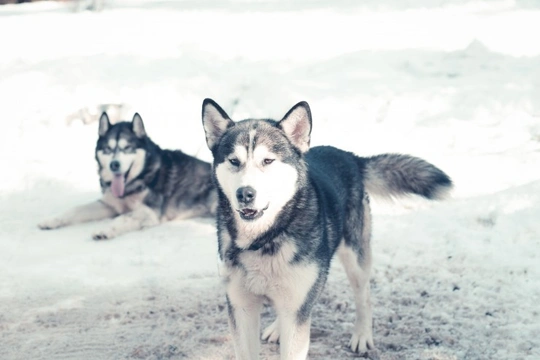
Top Pack Dog Breeds in the UK: Loyal and Social Companions
Dogs are naturally social animals that instinctively seek the company of their own kind. In the wild, their pack structures offer safety, increased chances of survival, and cooperative strength, essential for defence and successful hunting. This pack mentality remains a crucial trait in many domestic dogs, shaping their behaviours and social needs.
In today’s domestic environment, social interaction with other dogs is vital for a dog's happiness and mental health. While every dog appreciates company to some degree, some breeds demonstrate a particularly strong pack orientation, thriving best within multi-dog households or active social settings.
Historically, pack-oriented breeds were developed for varied cooperative roles like sledding, hunting, and herding, emphasizing teamwork and social cohesion. If you’re considering buying a dog or adding to your existing canine family, understanding which breeds naturally enjoy and excel in pack life is important. This guide illuminates some of the top pack breeds popular in the UK in 2025, focusing on their social behaviour, temperament, exercise needs, and how well they adapt to families with multiple dogs.
The Siberian Husky
The Siberian Husky is renowned for its high energy and endurance, requiring lots of daily exercise and mental stimulation to avoid boredom. Originating as sled dogs, they traditionally lived and worked in tightly knit packs, hauling sleds across challenging icy terrains, which fostered their natural pack instincts and cooperative nature.
Siberian husky puppies are outgoing, social dogs that flourish when they have company, especially other dogs. They are well suited to families who can meet their rigorous exercise needs and enjoy an active lifestyle alongside their pet.
The Beagle
The Beagle has a rich heritage as a cooperative hunting dog, traditionally living in close-knit packs during fox and stag hunts. This history has imbued them with a highly social and playful temperament, thriving when surrounded by other dogs and humans alike.
Beagles, including beagle puppies, do best in multi-dog homes or where they have a consistent canine companion. Their exuberant and curious nature requires regular exercise and mental stimulation to keep them content and well-behaved.
The Foxhound
The Foxhound shares a similar pedigree, historically bred for cooperative fox hunting. This breed carries strong pack instincts and a naturally sociable disposition, making them highly compatible with other dogs and people.
Foxhound puppies require extensive exercise and socialisation, plus experienced handling at home to channel their active, hunting-driven instincts positively. When well managed, they add lively companionship to multi-dog families.
The Border Collie
Known as one of the most intelligent dog breeds, the Border Collie combines high intelligence with boundless energy. Developed primarily as a herding dog, they work well alone but are also excellent team workers, often managing herds cooperatively.
For owners considering border collie puppies, it’s essential to provide challenging physical and mental activities. They can live peacefully in multi-dog households but require an experienced owner who understands their unique needs and potential herding instincts.
The Alaskan Malamute
The Alaskan Malamute is a large, strong sled dog bred for hauling heavy loads in harsh environments. Like the Siberian Husky, they have a pack-oriented nature and enjoy social companionship, quickly adapting to established dog groups.
Alaskan malamute puppies are affectionate and outgoing, but due to their size and strength, require early socialisation and firm, consistent training to interact safely with other dogs and family members. They thrive in homes where they can exercise extensively and socialise regularly.
Summary of Pack Dog Traits
| Breed | Pack Compatibility | Temperament | Suitability for Multi-Dog Homes | Exercise Needs |
|---|---|---|---|---|
| Siberian Husky | Highly social, thrives in packs | Energetic and outgoing | Excellent | Very high |
| Beagle | Pack hunter, sociable | Playful and friendly | Excellent | High |
| Foxhound | Strong pack hunter instincts | Friendly and sociable | Very good | Very high |
| Border Collie | Social but focused on tasks | Intelligent and driven | Good with experienced owners | Very high |
| Alaskan Malamute | Pack-oriented and affectionate | Strong but friendly | Good with supervision | Very high |
Tips for Adding a Pack Dog to Your Home
- Meet the Social Needs: Dogs with pack instincts require regular interaction with other dogs for mental wellbeing. Consider breeds known for their social nature if you plan multiple dogs.
- Consider Exercise Levels: Many pack breeds have very high stamina and energy. Providing daily exercise and mental challenges will prevent behavioural problems.
- Gradual Introduction: When introducing a new dog to an existing pack, gradual and supervised meetings reduce stress and ease adaptation.
- Responsible Sourcing: Choose reputable breeders or consider rescue from shelters to promote ethical ownership.
- Training and Socialisation: Early training is critical for managing pack dynamics and ensuring harmonious home life.
Conclusion
Choosing a pack-oriented dog breed can lead to a lively, social, and cooperative household where dogs thrive on companionship. The Siberian Husky, Beagle, Foxhound, Border Collie, and Alaskan Malamute are standout examples in the UK for families seeking active, loyal pack dogs.
Remember that while these breeds cherish social interactions, they require commitment to their exercise and training needs. Responsible ownership, combining physical activity, mental engagement, and social opportunities, will ensure your pack dogs live happily and healthily together.



